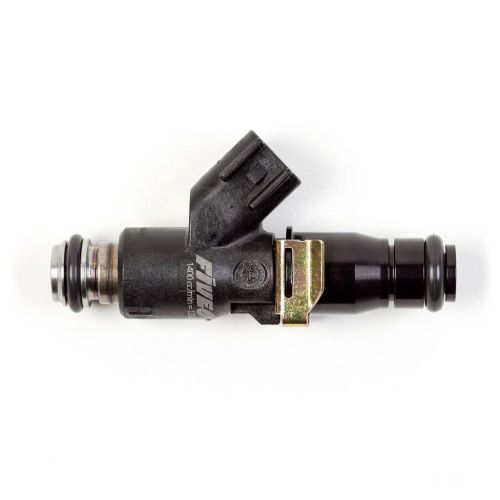The Main Principles Of Fuel Injectors
Table of ContentsTop Guidelines Of Fuel InjectorsThe Definitive Guide to Fuel InjectorsFuel Injectors - Truths
The fuel is injected only into the pre-chamber (where it begins to combust), and not straight into the main combustion chamber. For that reason, this principle is called indirect injection. There exist a number of slightly various indirect injection systems that have comparable attributes. All Akroyd (hot-bulb) engines, and some Diesel (compression ignition) engines use indirect injection.This can be done either with a blast of air (air-blast injection), or hydraulically. The latter method is even more common in automotive engines. Usually, hydraulic direct injection systems spray the fuel into the air inside the cylinder or combustion chamber, however some systems spray the fuel versus the combustion chamber walls (M-System).
The latter is the most common system in modern-day automotive engines. Direct injection is appropriate for a big range of fuels, including petrol (see gas direct injection), and diesel fuel. In a typical rail system, the fuel from the fuel tank is provided to the common header (called the accumulator).
The header has a high pressure relief valve to keep the pressure in the header and return the excess fuel to the fuel tank. The fuel is sprayed with the help of a nozzle that is opened and closed with a needle valve, run with a solenoid. When the solenoid is not activated, the spring forces the needle valve into the nozzle passage and avoids the injection of fuel into the cylinder.

Third-generation common rail diesels use piezoelectric injectors for increased precision, with fuel pressures as much as 300 MPa or 44,000 lbf/in2 - fuel injectors. Air-blast injection system for a 1898 diesel motor In 1872, George Bailey Brayton acquired a patent on an internal combustion engine that utilized a pneumatic fuel injection system, also created by Brayton: the air-blast injection.
Most notably, Diesel increased the air-blast pressure from 45 kp/cm2 (390490 kPa) to 65 kp/cm2 (6,400 kPa). The first manifold injection system was developed by Johannes Spiel at Hallesche Maschinenfabrik in 1884. In the early 1890s, Herbert Akroyd Stuart developed an indirect fuel injection system utilizing a 'jerk pump' to meter out fuel oil at high pressure to an injector.
A manifold-injected Antoinette 8V aviation engine, installed in a maintained Antoinette VII monoplane airplane. In 1898, Deutz AG started series production of stationary four-stroke Otto engines with manifold injection. Eight years later, Grade equipped their two-stroke engines with manifold injection, and both Antoinette 8V and Wright airplane engines were fitted with manifold injection as well.
Fuel Injectors Can Be Fun For Anyone

:max_bytes(150000):strip_icc()/Fuelinjector-5c2ce49a46e0fb00014ac030.png)
Due to the wartime relationship between Germany and Japan, Mitsubishi also had 2 radial aircraft engines using fuel direct injection, the Mitsubishi Kinsei and the Mitsubishi Kasei. The very first automobile direct injection system used to run on gas was established by Bosch, and was presented by Goliath for their Goliath GP700, and Gutbrod for their Superior in 1952.
The 1954 Mercedes-Benz W196 Formula 1 racing vehicle engine utilized Bosch direct injection derived from wartime aircraft engines. Following this racetrack success, the 1955 Mercedes-Benz 300SL, ended up being the very first automobile with a four-stroke Otto engine that used direct injection. best site Later on, more mainstream applications of fuel injection favored the less-expensive manifold injection.
6 litre V8 with Rochester manifold fuel injection Unpowered, continuously injecting multi-point injection Bosch K-Jetronic Throughout the 1950s, several makers presented their manifold injection systems for Otto engines, consisting of General Motors' Rochester Products Department, Bosch, and Lucas Industries. Throughout the 1960s, extra manifold injection systems such as the Hilborn, Kugelfischer, and SPICA systems were presented.
Preliminary issues with the view it Electrojector meant just pre-production vehicles had it installed so extremely couple of vehicles were offered and none were offered to the general public. The EFI system in the Rambler worked well in warm weather, but was difficult to begin in cooler temperatures. Chrysler offered Electrojector on the 1958 Chrysler 300D, DeSoto Adventurer, Dodge D-500, and Plymouth Fury, probably the very first series-production cars and trucks equipped with an EFI system.
The D in D-Jetronic represent Druckfhlergesteuert, German for "pressure-sensor controlled"). The D-Jetronic was initially used on the VW 1600TL/E in 1967. This was a speed/density system, using engine speed and consumption manifold air density to calculate "air mass" circulation rate and hence fuel requirements. Bosch superseded the D-Jetronic system with the and systems for 1974, though some vehicles (such as the Volvo 164) continued utilizing D-Jetronic for the following numerous years.
10 Simple Techniques For Fuel Injectors
This approach needed extra sensors to measure the atmospheric pressure and temperature level, to determine mass circulation rate. L-Jetronic was widely adopted on European cars and trucks of that duration, and a couple of Japanese designs a short time later. The first digital engine management system (engine control system) was the Bosch Motronic introduced in 1979.
The EEC-III a single-point injection system. Manifold injection was phased in through the latter 1970s and 80s at a speeding up rate, with the German, French, and U.S. markets leading and the UK and Commonwealth markets lagging somewhat. Because the early 1990s, nearly all petrol automobile offered in very first world markets are geared up with electronic manifold injection.
Fuel injection systems are gradually changing carburetors in these nations i loved this too as they adopt emission regulations conceptually similar to those in force in Europe, Japan, Australia, and The United States And copyright. In 1995, Mitsubishi provided the very first common-rail gas direct injection system for automobile. fuel injectors. It was introduced in 1997. Consequently, common-rail direct injection was also presented in guest vehicle diesel engines, with the Fiat 1.